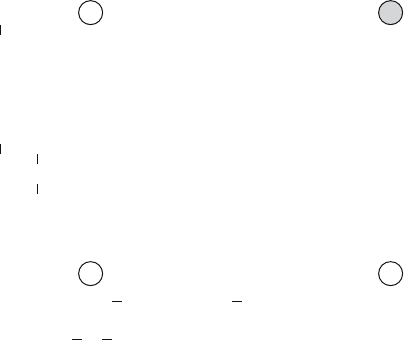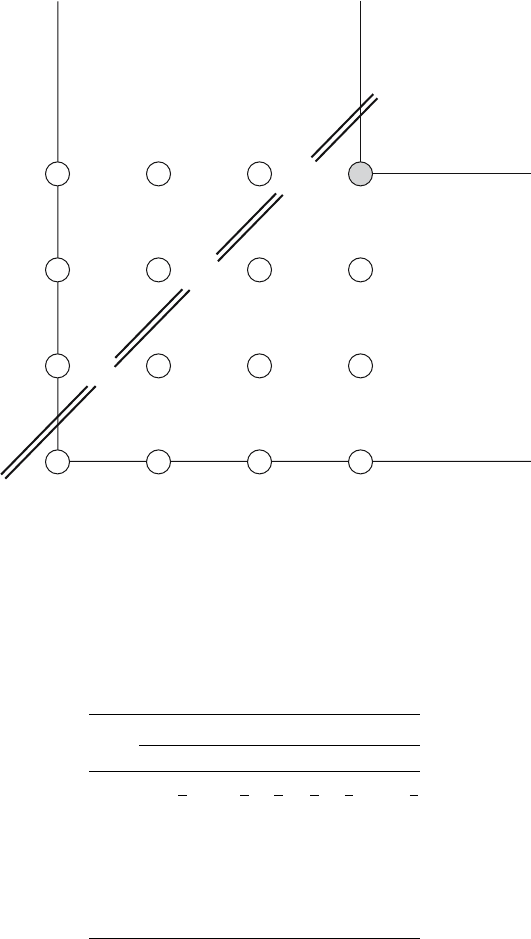Keyfitz N., Caswell H. Applied Mathematical Demography
Подождите немного. Документ загружается.


16.6. Parental Control over Sex of Children 435
We could have anticipated this by noting that to move up one girl takes
on the average 1/g children; hence to move up two girls takes 2/g children.
To move up three girls takes an average of 3/g children, and similarly for
higher numbers. The cells for boys only, across the top of the diagram, are
the same but with b replacing g.
Hence the expectations shown on the right-hand points and across the
top of the diagram; having attached probabilities to these boundary points,
we now turn to the interior. Consider the interior point marked A in Figure
16.5, standing for a couple wishing one girl and one boy, either altogether
or in addition to the children they already have.
Suppose they try for a girl first. Then the chance of moving up in the
diagram is g, and if they succeed they reach the point just above, from
which the expectation is 1/b. If they fail they reach the point at the right,
from which the expectation is 1/g. Hence the total expected number of
children from point A is
A
g
= g
1+
1
b
+(1− g)
1+
1
g
,
where 1 has been added within the parentheses to allow for the girl or boy
born in the move. On cancellation this reduces to
g
b
+
1
g
,
and with b =0.8andg =0.7equals0.7/0.8+1/0.7=2.30.
Using the opposite strategy of trying for a boy first (Figure 16.5) would
give
A
b
= b
1+
1
g
+(1− b)
1+
1
b
=
b
g
+
1
b
,
or, with our numbers, 0.8/0.7+1/0.8=2.39. Evidently the right strategy
is to try for a girl first. This suggests a general rule: parents should leave
the more controllable contingency to the last if they seek equal numbers of
boys and girls.
We want always to choose the strategy that gives the minimum number
of total children, for example, that corresponds to
Min
g
b
+
1
g
,
b
g
+
1
b
.
If b>g, that is, if we are surer to get a boy if we aim at a boy than a girl
if we aim at a girl, it is easily seen by algebra that b/g +1/b > g/b +1/g.
This is so because, if b>g>
1
2
,thenb −
1
2
>g−
1
2
and (b −
1
2
)
2
> (g −
1
2
)
2
,
or b
2
−b>g
2
−g; therefore b
2
+ g>g
2
+ b, and, on dividing both sides by
bg, b/g +1/b > g/b +1/g.Ifb>gwe should try for a girl first to minimize
total children.
The ability of parents to influence the sex of their children will reduce the
average number of offspring for parents targeting on a minimum number of

436 16. Microdemography
Want one
(more)
girl
Want one
(more)
boy Target
CA
1/g
1/b
B
A = Min (A
g
, A
b
)
A
b
= b
(
1 +
)
+ (1 – b)
(
1 +
)
g
1
g
b
b
1
b
1
= +
A
g
= g
(
1 +
)
+ (1 – g)
(
1 +
)
b
1
b
g
g
1
g
1
= +
Figure 16.5. Enlargement of part of Figure 16.4, showing expected children for
couple wanting one boy and one girl (position A). Trying for a boy first gives an
expected A
b
= b(1 + 1/g)+(1− b)(1 + 1/b)=b/g +1/b children. Trying for a
girl first gives A
g
(1 + 1/b)+(1−g)(1 + 1/g)=g/b +1/g children, where b is the
chance of having a boy if the couple try for a boy, and g is the chance of having
a girl if they try for a girl.
boys and of girls. Figure 16.6 shows expected numbers from various points
with b =0.8,g=0.7, and in parentheses with b =0.5,g=0.5.
Let us see how sensitive the result is to the degree of reliability with
which sex is determined. Table 16.4 shows the cases of parents aiming at
one boy, and at one boy and one girl. Making b = g =0.5, 0.6,..., we
see the average number of children they will have. If b = g =0.8 rather
than b = g =0.5, the expected total drops from 2.0 to 1.25 for couples
aiming at one boy, and from 3.0 to 2.25 for couples aiming at one boy and
one girl. In both cases the reliability of 0.8 in sex determination eliminates
three-quarters of the unwanted children.
A number of surveys have asked newly married couples how many boy
and how many girl children they want. One such survey in Hull, England,
showed 45.7 percent wanting one boy and one girl, 15.4 two boys and one
girl, and 12.6 two boys and two girls; the average was 2.55 children. Under
present circumstances, that is to say with b = g =0.5 approximately,
we find by applying the numbers in parentheses in Figure 16.6 to these
percentages that the average attained would be 3.74 children, or 1.19 more
than wanted (Table 16.5).

16.6. Parental Control over Sex of Children 437
Boys
Girls
Try for boy first
Try for girl first
Absorbing barrier
Absorbing barrier
3 2 1 0 boys
3210
0
girls
Try for boy first
Try for girl first
Aiming at
Aiming at
b = 0.8
g = 0.7
3.75
(6.00)
4.424
(6.25)
5.390
(6.88)
6.418
(7.88)
2.50
(4.00)
3.343
(4.50)
4.381
(5.50)
5.482
(6.88)
1.25
(2.00)
2.304
(3.00)
3.471
(4.50)
4.714
(6.25)
1.43
(2.00)
2.86
(4.00)
4.29
(6.00)
Figure 16.6. Expected number of children for various family objectives from zero
boys and zero girls up to three boys and three girls, when b =0.8,g=0.7, and
(in parentheses) when b = g =0.5.
Table 16.4. Expected number of children born to couples who stop after one boy,
and who stop after one boy and one girl
Expected total stopping after
One boy One boy and one girl
b = g
1
b
g
b
+
1
g
=
b
g
+
1
b
=1+
1
b
0.5 2.0 3.0
0.6 1.67 2.67
0.7 1.43 2.43
0.8 1.25 2.25
0.9 1.11 2.11
1.0 1.00 2.00
With b =0.8,g =0.7, numbers chosen because they are about halfway
to complete sex control represented by b = g =1.0, the average would be
2.88 children, or only 0.33 more than wanted.

438 16. Microdemography
A technology that goes halfway to sex control would eliminate nearly
three-quarters of the unwanted children born because of the sex preferences
of parents. Full sex control would reduce the birth rate for these parents
by 32 percent; half sex control would reduce their birth rate by 23 percent.
Five kinds of qualification are required. The least important is that chil-
dren are born one at a time in the model, which has no easy way of taking
account of multiple births. Moreover, not all parents have preferences re-
garding the sex composition of their families, and the model deals only with
parents whose preferences are strong enough to be overriding. In fact, they
must be willing and able to have an infinite number of children if necessary.
The model also supposes that the parental decision regarding composition
is made at the outset rather than in stages, or child by child. It supposes
homogeneity—that all parents have the same chances b and g.
The advent of partial or complete control of the sex of children would
have the effect of changing the sex of the new generation, in some cultures
in favor of boys; in those cultures the advent of a high sex ratio in the new
generation would reduce the number of marriages; when the children came
to childbearing age marriages would be limited by the less numerous sex.
Unwed males would decrease the overall birth rate. But well before that
came about the culture would shift in favor of the initially less favored sex.
Within a decade or so of the birth of a disproportionate number of boys
couples would come to value girls more highly. Perhaps a series of waves
would ensue, not unlike those familiar in a market economy arising from
the interval of time between capital investments and the returns therefrom
(Westoff and Rindfuss 1974). For an insightful analysis of some of the de-
mographic consequences of sex selection in recent China, see Tuljapurkar
et al. (1995).
Table 16.5. Application of average numbers of expected children to sex preferences
of parents in survey in Hull, England
Number of children
Average
Average born with
Parents’ born with b =0.8,
preferences Percent Wanted b = g =
1
2
g =0.7
One boy, one girl 45.7 2 3.0 2.304
Two boys, one girl 15.4 3 4.5 3.343
Two boys, two girls 12.6 4 5.5 4.381
Average of survey 2.55 3.74 2.88
Excess with b = g =
1
2
3.74 − 2.55 = 1.19
Excess with b =0.8,g =0.72.88 − 2.55 = 0.33

16.7. Mean Family Size from Order-of-Birth Distribution 439
16.7 Mean Family Size from Order-of-Birth
Distribution
Birth certificates almost invariably require that mothers report whether a
particular birth is their first, second, third, and so on. The resultant order-
of-birth tabulations are available for many countries and regions, and one
would like to extract their implication for the mean number of children
born to mothers. The problem was considered by Burks (1933) and others.
The early writers assumed a stationary condition, in which the distribu-
tion of births by order in a calendar year or other period of observation is
the same as in the cohorts of mothers that are passing through the period
in question; the several cohorts are taken as of equal size. Suppose that
the observed number of first births is N
1
, of second births is N
2
,andso
on, and that these numbers apply in all periods and for all cohorts. This is
to say that N
1
is the total of women who have any children at all, N
2
the
number who have two or more children, N
3
the number who have three or
more children, for all periods and all cohorts. If we call φ
1
the number who
stop with one child, φ
2
the number who stop with two children, and so on,
the N’s are the cumulative sums of the φ’s:
N
1
= φ
1
+ φ
2
+ φ
3
+ ···
N
2
= φ
2
+ φ
3
+ ···
N
3
= φ
3
+ ···
.
.
.
and the φ’s are the differences of the N’s:
φ
1
= N
1
− N
2
φ
2
= N
2
− N
3
φ
3
= N
3
− N
4
.
.
.
Themeannumberofchildreninafamilythathaschildrenis
φ
1
+2φ
2
+3φ
3
+ ···
φ
1
+ φ
2
+ φ
3
+ ···
=
N
1
+ N
2
+ N
3
+ ···
N
1
=
N
N
1
=
Total births
First births
.
(16.7.1)
This highly simplified formula applied to United States data for 1933
requires only the fact that births in that year were 74 per thousand native
white women 15 to 44 years old, and first births were 24, making a mean
family size of 3.1 children. For 1956 the corresponding figures were 115, 33,
and a mean family size of 3.5 children; for 1973 the mean was 2.40.

440 16. Microdemography
16.8 Parity Progression and Population Increase
How parents decide the size of their families has been the subject of much
investigation since effective birth control has made that size subject to
deliberate decision. Some may have a concept at the beginning that they
retain throughout—they are fixed on three children, say. The majority,
however, seem to make up their minds as they go along—they have one
child and then, depending on how things look, they decide whether to have
another. The following argument suggested by Norman Ryder formalizes
parental decision in terms of the probabilities of successively proceeding to
each further child.
Disregard time and consider the married couples that have children of
successive orders. Suppose that a certain fraction of women have a first
child; of these a certain fraction have a second child; of those that have two
children a certain fraction go on to a third; and so on. We might take as
the cohort a group of couples that married at the same time, or a group of
women born at the same time. We could include a symbol for the fraction
r
0
of the cohort that survives, and another for the fraction that marries,
but simplicity is served by just supposing that r
1
of the girls born at a
given moment will grow up and have a first child, of these the fraction r
2
will go on to a second child, and so on.
Then the probability that a girl child will have at least one child is r
1
,
that she will have two children is r
1
r
2
, and so on. Suppose that the ratio of
boys to girls among the births of any order is s, so the fraction 1/(1 + s)of
the births are girls. The net reproduction rate of the cohort of which the
girl in question is a member is
R
0
=
1
1+s
(r
1
+ r
1
r
2
+ r
1
r
2
r
3
+ ···). (16.8.1)
Due allowance is implicitly made for mortality, nonmarriage, illegitimacy,
and voluntary or involuntary sterility within marriage.
We can enable the notion of parity progression to serve us better by
reducing the parameters in (16.8.1) from one for each child to just two in
all. Ryder found that r
1
≈ r
2
= h,say,andthatr
3
≈ r
4
≈ r
5
≈···= k,
say. Then (16.8.1) becomes
R
0
=
1
1+s
(h + h
2
+ h
2
k + h
2
k
2
+ h
2
k
3
+ ···)
=
1
1+s
h +
h
2
1 − k
.
Table 16.6 shows values of R
0
for various combinations of h and k;the
combinations on the lower right give an increasing population.
With this result we can do experiments of various kinds. We can, in
particular, see how R
0
would be modified by lowering k,whichistheway
in which fertility change seems largely to have taken place in the United

16.9. Lower Mortality and Increase 441
Table 16.6. Net reproduction rate corresponding to mothers’ parity progression
ratio, h for first and second child, and k for subsequent children, according to
(16.8.2)
hk
0.40 0.45 0.50 0.55 0.60 0.65 0.70
0.60 0.59 0.61 0.64 0.68 0.73 0.79 0.88
0.65 0.66 0.69 0.73 0.78 0.83 0.91 1.00
0.70 0.74 0.78 0.82 0.87 0.94 1.02 1.14
0.75 0.82 0.86 0.91 0.98 1.05 1.15 1.28
0.80 0.91 0.96 1.01 1.08 1.17 1.28 1.43
0.85 1.00 1.06 1.12 1.20 1.30 1.42 1.59
States. Now, since
R
0
=
1
1+s
h +
h
2
1 − k
, (16.8.2)
we have
dR
0
dk
=
1
1+s
h
1 − k
2
.
Around s =1.05,h =0.80,k =0.65, we have dR
0
/dk =2.55, so that each
increase of 0.01 in k produces an increase of 0.0255 in R
0
,andsimilarlyfor
decreases.
To see the effects of successive childbearing decisions on population
growth we need also to take account of timing. The age at which a woman
has her first child, and the successive interbirth intervals, will evidently
make a difference in the rate at which the population grows. Timing is the
one element lacking in the present model. For the effect of its omission,
consider h =0.80 and k =0.65, so that R
0
=2.63/2.05 = 1.28. If the
mean age of childbearing (strictly, the length of generation) is 25 years, the
intrinsic rate is 0.0099; if it is 30 years, the intrinsic rate is 0.0082.
16.9 For a Given Probability of Survivors, Lower
Mortality Lowers the Rate of Increase
When mortality is high, a man who wants to have a son who will see him
through his old age requires many children. This point has often been made
before, but we still need clarification of the relation between mortality and
the rate of population increase among people who want a certain assurance
of surviving children. With number of births given, the rate of increase r
goes up as mortality µ
x
goes down; we will see that the relation between
r and µ
x
is reversed if the birth rate is determined by the wish to have
surviving sons.

442 16. Microdemography
Table 16.7. Rate of increase r of populations with values of l
30
from 0.5 to 0.9
and probability p of at least one living son of 0.8 and 0.9; tabulation of (16.9.4)
l
30
p =0.8 p =0.9
0.5 0.0050 0.0169
0.6 0.0017 0.0137
0.7 −0.0022 0.0097
0.8 −0.0074 0.0045
0.9 −0.0155 −0.0035
Call the probability of at least one surviving son p; this must equal one
minus the probability that all sons will die. Consider survivorship to father’s
age 60; then the probability that not all sons will die is
1 − (1 − l
60−a
1
)(1 − l
60−a
2
) ···(1 − l
60−a
n
)=p (16.9.1)
if the first son is born at age a
1
of the father, the second at age a
2
,...,and
the nth at age a
n
.
Now the rate of increase of the population for this particular family, still
on the one-sex model but for males, is the real root in r of the equation
n
i=1
e
−ra
i
l
a
i
=1. (16.9.2)
This discrete form of Lotka’s characteristic equation can be solved for r to
tell us what r would be in a population if the mortality and childbearing
patterns of a particular family were general.
Our problem is to find r as a function of the life table l
a
from (16.9.2),
given that the number of children n will be determined by (16.9.1). Even
to define the solution of this would be awkward, so we approximate by
supposing all the children to be born at the same age of the father: a
1
=
a
2
= ···= 30, say. Then the first equation, (16.9.1), is
1 − (1 − l
30
)
n
= p,
or
n =
log(1 − p)
log(1 − l
30
)
. (16.9.3)
The second equation, (16.9.2), is
ne
−30r
l
30
=1;
and substituting n from (16.9.3) and taking logarithms gives
r =
1
30
log
l
30
log(1 − p)
log(1 − l
30
)
. (16.9.4)
Thevaluesofr are shown in Table 16.7, whose most important message
is that each rise in l
30
of 0.1 causes a decline in r of 0.003 to 0.008. The
16.9. Lower Mortality and Increase 443
point seems to be that the improvement in mortality permits a decline in
the number of children sufficiently great that the births drop more than
enough to offset the fall in mortality. Heer (1966) has applied simulation to
this problem, and his more complex model produces an inverted U -curve
in r.
Note that n, being the number of children, ought to be an integer, and if
p is to be assured it ought to be the next higher integer to the expression
on the right-hand side of (16.9.3). For some combinations of high p and low
l
30
the n implied in (16.9.3) will be an impossibly large number of children.
This does not apply, however, to the range shown in Table 16.7, for which
1to4malechildrensuffice.
Note that as l
30
moves toward unity a discontinuity exists, for r goes
steadily downward with 1 − l
30
for any fixed value of p; but we know that
l
30
= 1 and r = 0 will provide with certainty the one child living at age 60
of the father. Evidently (16.9.4) is not to be taken seriously as mortality
falls very low, or when other than small positive values of n 1 are implied.
17
The Multi-State Model
The life table was in use for some centuries before anyone noticed that
the transition from life to death is an instance of much more general
transitions—from well to sick, from school to work, from single to mar-
ried, from working to unemployed, from living in Province A to living in
Province B, from fecund to pregnant. For each of these, and many other
transitions, a decrement table can be made, and the usefulness of doing so
has been recognized in field after field. To study schooling, one routinely
makes life tables of survival in school as against dropping out; to study the
effectiveness of a contraceptive, one makes a life table of those remaining
fecund versus those falling into pregnancy.
The technique could well be applied more extensively. For unemploy-
ment, we ought to know not only the total number at a given moment and
the fraction they are of the labor force, but also the probability that an
unemployed individual will find a job next month, the month after, or the
month after that. With ten percent unemployment in the country, it makes
a great deal of difference whether everyone in the labor force is out of a job
for 5 weeks a year, or one tenth of the labor force is out for 50 weeks. The
life table form would tell a person of certain characteristics who has just
lost his job the chance of being out of work for 1 month, 2 months, etc.
All these would be single decrement life tables, calculable by exactly the
same technique as has been used for the representation of mortality these
last 300 years. There is no need to adapt the life table method to them; the
method is immediately applicable. This chapter goes beyond them into the
realm of multiple contingencies. The person now out of work has a certain
